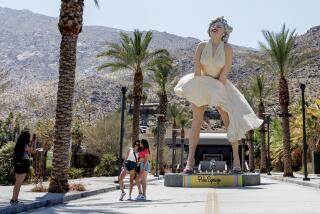Long-Lost Tribute to Environmental Movement Is Back : Monuments: Miss American Green Cross, lost for two decades and newly restored, will be dedicated today in Brand Park.
- Share via
GLENDALE — Once lost for two decades and later damaged during years of neglect, the restored Miss American Green Cross monument will be dedicated today in Brand Park in the memory of a 1920s environmental movement that originated in Glendale.
At a 9 a.m. ceremony Glendale artist Ron Pekar will describe the two-year restoration of the environmentally themed monument consisting of a woman in bronze standing before a large cement cross and spreading her arms over cement logs.
“It’s as near to the original as any artist can get it,” Pekar said, adding that it was not strictly a restoration project. “Restoration is based on there being something to restore. The monument wasn’t there, so I needed to re-create it from the original.”
Unveiled in May, 1928, in front of Glendale High School, the Frederick Willard Proctor statue was built in tribute to the American Green Cross, a national organization that began in Glendale in 1926 and promoted the conservation of trees and other natural resources. The Green Cross movement faded from sight in the 1930s. About the same time, the monument disappeared. It was rediscovered in a remote area of Brand Park in the 1950s and, in 1977, was listed in the Glendale Historic Preservation Element, a plan for protecting historic sites and properties.
In 1990, Nello Iacono, director of the city’s Parks, Recreation and Community Services Department, decided the statue should be restored and moved to a more prominent spot in Brand Park. By then, however, the statue was severely dilapidated. The cross and logs had deteriorated and the statue had lost its arms.
“It had scratches, scars, paint and bullet holes,” said Pekar, a local sculptor and painter who also teaches art at Cal State Northridge.
The project was initially, estimated to cost $25,000. But it became more complicated when the Historical Preservation Commission, which has jurisdiction over the monument, objected to Pekar’s plan to use new materials for the cross and logs to make them more resistant to vandalism.
“With the changes, it wouldn’t have meant the same thing,” Commissioner William E. Dodson said.
The commission voted to require that Pekar match the original bronze and cement.
The difficulty escalated again when the commission learned that the statue once had a large base. A local history buff found early photographs of the monument and presented them at the commission’s Sept. 17, 1990, meeting. The commission decided the base must also be rebuilt.
The project eventually cost between $60,000 and $65,000, according to Iacono, due to the addition of the base and the extra work involved in making latex molds for the cement logs and cross. Funding came from the city’s capital improvement budget and public arts fund.
Pekar worked from photographs and old newspaper articles to re-create the 18-foot-high monument weighing about 17 tons, of which the statue is only 400 pounds.
Over the past few days, the monument was set into position by crane in its new home adjacent to the Brand Studios and Brand Library. The statue was installed Tuesday.
More to Read
Sign up for Essential California
The most important California stories and recommendations in your inbox every morning.
You may occasionally receive promotional content from the Los Angeles Times.













